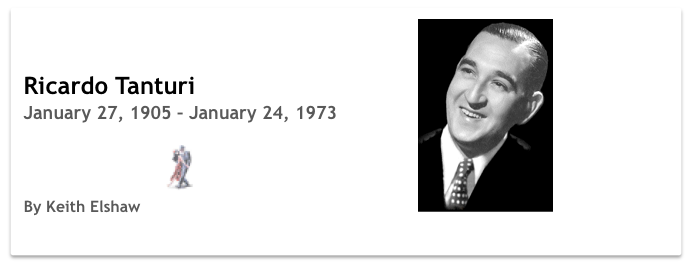Pocas palabras (1941) with Alberto Castillo
Question: which tango orquesta's records have come down to us sounding the worst technically?
A: all of the above. But in a tie for 1st certainly are Ricardo's. And something extra bad happened to his work: our auditory perception of what his orquesta sounded like has been warped to a large extent.
My case is made by comparing his sound with his two main singers, Castillo and Enrique Campos. For years I thought he had made a big change in his lineup because the Campos recordings sound so different.
How surprised was I to hear what happened when I got to restoring them: it sounds like the same band after-all. My perception had been tricked by the awful quality of the reproductions. Poor Ricardo.
At one point in the 60s, some record exec had the brilliant idea of adding reverb to Tanturi recordings. Ugh.
But of course the thing is the music and performances are so wonderful that we just ignore the technical stuff. Tanturi must be played every milonga.
If you listen to Pocas palabras you will hear the best representation of what he sounded like without all the noise, distortion, booming bass, etc. that muddied all the records we got.
What would we do without mentors. In my early tango days I wasn't paying attention to Tanturi. Well, in the beginning you can only absorb so much but if the records had sounded better I would have heard it sooner. And then I started hanging out with Carlos Gavito. Those of you who knew Carlos know exactly what I'm going to say.
He loved Tanturi with such passion. You could go through whole classes with Carlos and hear virtually nothing but Tanturi. So of course I got it then. And we talked about so many things over many long late-night rambles during a couple of years, just the two of us. That's when I learned what a serious student of tango Carlos was. My wife at the time was his first teacher/professional partner when he joined the Copes company, so we had an affinity. You learned so much from Gavito if he just got talking.
Tanturi's music is for no-"steps" tango particularly. For the dancer who loves tango tango; for the dancer who needs to express emotions. So my personal relationship with Tanturi began as a dancer, not as a musicologist. I was enthralled with learning social tango at the time and Gavito was my guide. He used Tanturi to lead me in. Thank you again and forever, carlitos.
Ricardo was a violinist who began his professional career when he was 20. In 1937 he first recorded under his name and although it's good music, he didn't have an identity. Every record sounded like an homage to an orquesta leader (Recuerdo by Pugliese) or a composer. From one record to the next it almost sounded like a different group. Of course this is explainable by the fact he wasn't using a singer. And then something momentous happened.
Enter Alberto Castillo in 1939. If ever the career of a band leader was saved by a singer, this is it. And vice-versa; they were a magical combination. And of course Alberto brought with him ... thousands of love-crazed fans!
The 30-odd records they recorded together set them both in the firmament.
Uruguayan Enrique Campos came in when Castillo left in'43. Although singing in the same vocal range, his personality lead Tanturi into a slightly different direction. Ricardo's music now has a more pensive, moody quality. It's romantic. Whereas you use Tanturi-Castillo to get the dancers up all through the first part of the evening, when it's time to slow things down a bit you know who you reach for.
In all of Ricardo's arrangements you hear sweet string voicings and lovely movement in his flow. Made for dancers! You have to love Tanturi's vals (with both singers) and certain of his milongas really get the blood circulating.

